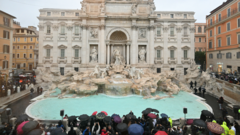Rome's beloved Trevi Fountain, a masterpiece of baroque architecture, has reopened following an extensive three-month restoration that has enhanced its aesthetics and structural integrity. Designed in the 18th century by architect Nicola Salvi and located on the façade of the Poli Palace, this iconic site once attracted between 10,000 to 12,000 visitors daily. To manage the influx of tourists and prevent overcrowding, the city has implemented a new queuing system aimed at creating a more enjoyable and orderly experience for all.
At the reopening ceremony, Mayor of Rome Roberto Gualtieri emphasized that these changes would allow for a more pleasant visit, minimizing the chaos previously experienced due to large crowds. He also hinted at the possibility of introducing a modest entry fee to help fund ongoing maintenance efforts.
The restoration focused on thorough cleaning to remove damaging mould and calcium deposits, ensuring the fountain is ready for the upcoming jubilee of the Roman Catholic Church, commencing on Christmas Eve. The fountain's importance is underscored by its historical connection to ancient Rome; it marks the endpoint of the Acqua Vergine aqueduct, which carries water for 20 kilometers (12 miles) before reaching the fountain.
Visitors have long cherished the tradition of tossing coins into the fountain, a custom that reportedly generates close to €10,000 each week for charity, supplying meals for those in need. The Trevi Fountain remains a vital part of Rome’s cultural fabric, with legends surrounding its healing waters tracing back to 19 BC. Known as Virgin Waters, it is said that the source was discovered by Roman soldiers who were guided there by a young virgin.
As part of the reopening festivities, many guests, undeterred by the light rain, participated in the beloved tradition by tossing coins into the fountain, continuing a ritual popularized by the classic film "Three Coins in the Fountain." With new visitor measures and ongoing preservation efforts, the Trevi Fountain is set to remain a cherished landmark for both locals and tourists alike.




















